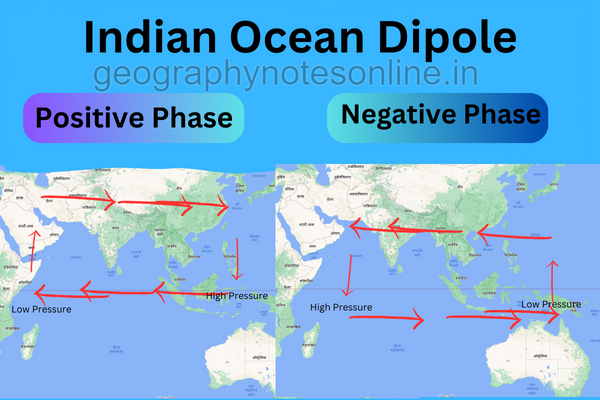Indian Ocean Dipole: A Climate Phenomenon 2023
Table of Contents

Indian Ocean Dipole
The Indian Ocean Dipole (IOD), a complex climate phenomenon, holds a crucial place in the world of oceanography and atmospheric science. Located in the Indian Ocean, this unique climate pattern influences weather systems, ocean currents, and rainfall patterns across the region. In this blog, we will delve into the intricacies of the Indian Ocean Dipole and explore its significance in understanding climate dynamics.
Understanding the Indian Ocean Dipole:
The Indian Ocean Dipole refers to the sea surface temperature anomalies that occur in the eastern and western parts of the Indian Ocean. It is characterized by the oscillation of warm and cold waters, creating a dipole-like pattern. The dipole events are classified into three categories: positive, negative, and neutral, based on the temperature differences between the western and eastern regions.
The Influence on Climate:
The Indian Ocean Dipole has a profound impact on regional climate patterns. During a positive phase, the western Indian Ocean experiences warmer-than-normal temperatures, while the eastern Indian Ocean cools down. This imbalance leads to the formation of a low-pressure system, resulting in increased rainfall over the western Indian Ocean and decreased rainfall over the eastern region. Conversely, during a negative phase, the opposite conditions prevail.
Relationship with El NINO and LA NINA:
The Indian Ocean Dipole and the El Niño-Southern Oscillation (ENSO) are interconnected climate phenomena. El Niño events in the Pacific Ocean can trigger a positive Indian Ocean Dipole, while La Niña events often coincide with a negative dipole. The interaction between these two climate systems can amplify or weaken their respective impacts on regional weather patterns.
Impacts on Agriculture and Fisheries:
The Indian Ocean Dipole exerts significant influence on agriculture and fisheries in the surrounding regions. Positive dipole events can bring abundant rainfall to countries like India, Indonesia, and Australia, enhancing agricultural productivity. Conversely, negative dipole events are associated with drought conditions, which can adversely affect crop yields and freshwater availability. Changes in oceanic conditions during dipole events can also impact marine ecosystems and fish populations.
Predictability and Forecasting:
Accurate prediction of the Indian Ocean Dipole is crucial for managing climate risks and taking timely measures. Advances in climate modeling and satellite technology have improved our ability to forecast dipole events. Several climate prediction centers and research institutes around the world closely monitor sea surface temperatures and atmospheric conditions in the Indian Ocean to provide early warnings and forecasts of dipole phases.
Conclusion
The Indian Ocean Dipole serves as a vital link in the intricate web of climate systems, influencing weather patterns, rainfall distribution, and agricultural productivity in the Indian Ocean region. Understanding this climate phenomenon is crucial for climate scientists, policymakers, and local communities to anticipate and adapt to changing climate conditions. As we continue to unravel the mysteries of the Indian Ocean Dipole through ongoing research and monitoring efforts, we gain valuable insights into the complex dynamics of our planet’s climate system, enabling us to make informed decisions for a more sustainable future.